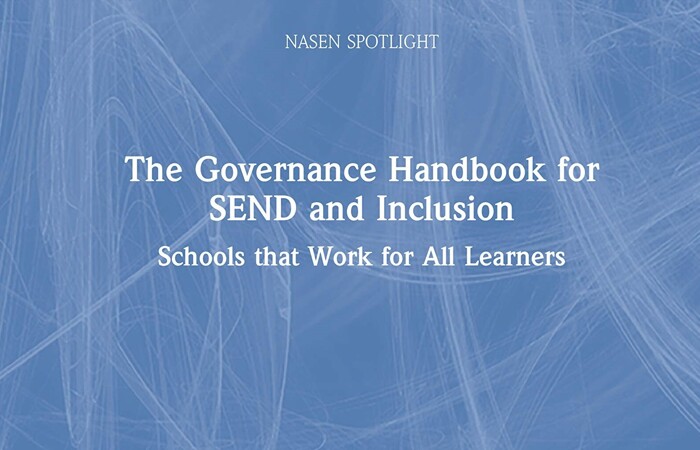Inspiration SEND Network Book Blog #9
Back
The Governance Handbook for SEND and Inclusion: Schools that Work for All Learners
Adam Boddison
(Abingdon: Routledge, 2021)
As someone new to SEND governance this handbook has proven extremely useful in outlining what is expected of me, as well as providing an overview of SEND and inclusion in schools and how this has evolved over time. It is a dense and richly informative book, packed with detail. However, if there was one pithy takeaway for me it would be the principle ‘Think SEND!’, highlighting how SEND should be considered in every decision being made, from changes in curriculum to alterations in the timetabling of the school day. This is something that will remain at the forefront of my mind when reflecting on the provision and culture of inclusion at my school.
The handbook is organized into five sections. First of all, Boddison provides an introduction to SEND (Special Educational Needs and/or Disabilities) and inclusion, explaining the legal, political and practical definitions of SEND, and highlighting how this area is constantly changing. Boddison notes the shift from the ‘medical model’ of disability, where a person with SEND needs to be ‘improved’ or ‘cured’ through medical, social or educational interventions, to the ‘social model’ of disability, where this is determined by the wider environment, and how the language we use has been influenced by both (e.g. from a diagnosis of SEND to an identification of differing needs). He also explains the notion of DME, or Dual and Multiple Exceptionality, sometimes referred to as twice exceptional (2E). DME is not a concept that I was familiar with as a layman and according to Boddison is something that has historically been overlooked. However, as he explains, recognition of DME is crucial to combat the damaging misconception that learners with SEND cannot also be academically gifted. Boddison also outlines the graduated approach as a framework to support learners with SEND, from ‘assess’, where possible educational needs are identified; ‘plan’, where provision is put in place to address specific needs; ‘do’, where schools work in partnership with pupils and families to implement the agreed provision, and finally ‘review’, where the effectiveness of the intervention is evaluated. Importantly, in this section Boddison also stressed the value of a ‘quality first’ approach to teaching, and how effective practice for learners with SEND is often effective practice for all learners. I was also particularly struck by the ‘equality, equity and liberation’ illustration representing the different philosophies of inclusion, as it helped me to visualize how adaptations to the learning environment can remove barriers to learning for everyone.
 Figure 1 The difference between the terms equality, equity, and liberation, illustrated; © Interaction Institute for Social Change | Artist: Angus Maguire
Figure 1 The difference between the terms equality, equity, and liberation, illustrated; © Interaction Institute for Social Change | Artist: Angus Maguire
The second section explores the key features of effective governance in relation to SEND and inclusion. Boddison stresses how ‘every leader should be a leader of SEND’, and how for a school to be truly inclusive this culture needs to be promoted through leadership decisions at every level. Following this, he looks at the specific practicalities of reviewing SEND governance and SEND provision in school. There is a helpful explanation of the differentiated roles of the school SENCO, the Headteacher and the SEND governor. Boddison observes how these roles are most productive when they are working in harmony as a triangle of SEND leadership within the school. Having recently been appointed as the Academy Committee Member with responsibility for SEND governance in my school, it was particularly useful in outlining my responsibilities as a ‘critical friend’ to the SENCO, advocating for SEND and providing both support and challenge to ensure the school’s culture is inclusive and its provision is meeting the requirements of all learners.
In the final section Boddison considers how data might be used to develop SEND provision and evaluate its effectiveness. He reflects on the way in which variations between a particular school’s data and the local context might highlight issues with identifying SEND, or with admissions practices. For those new to SEND governance the book’s appendices are also incredibly useful, with the first focused on practical resources and signposting relevant organisations, such as SEND Gateway, nasen, and the National Governance Association. Also included is a glossary of acronyms, from the commonly understood ADHD ‘attention deficit hyperactivity disorder’, right through to the less widely known WSS ‘Whole School SEND’. Since joining the Academy Committee, I have noticed that school leadership and staff often speak in acronyms and one can find oneself rather at sea when not using these on a daily basis, so I particularly welcomed having this glossary as a reference!
Without doubt, this book has given me greater confidence in planning monitoring meetings with the SENCO in my setting, through signposting things to be looking out for, pertinent questions to ask, data that might be useful, and how a culture of inclusion can be promoted at every level. Moving forward, I will endeavour to ‘Think SEND!’ to ensure that ‘no child is missed’ and ‘no child misses out’.
Dr Emily Peirson-Webber, Charles Darwin Academy Committee Member, SEND, February 2023
